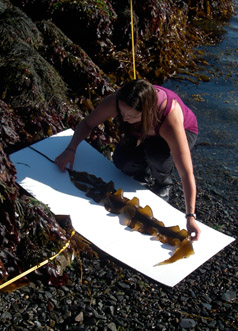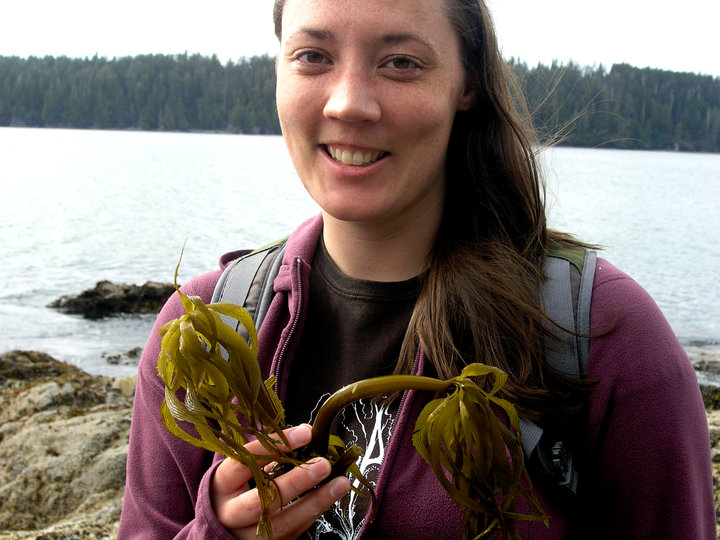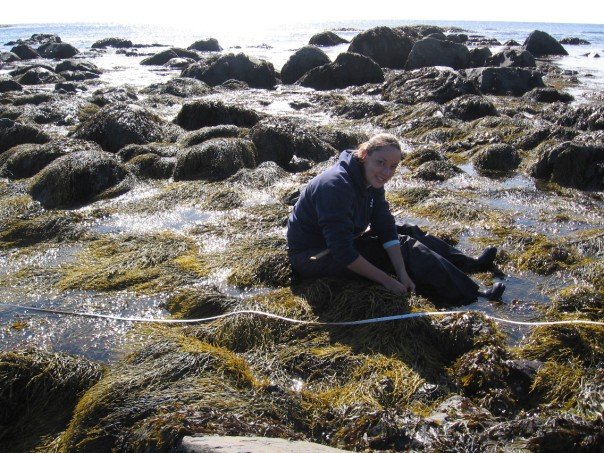Caroline Longtin
PhD Student
« Return to Home Page «« Return to Lab Members
 |
Caroline LongtinPhD Student My research interests focus on seaweed ecology, specifically factors influencing the distribution patterns of certain algal species. My first introduction to marine macroalgae was from Dr. Robert DeWreede during the Bamfield Marine Sciences Centre Fall Program (Bamfield, B.C.). I was so engaged in the phycology course that I chose to conduct my direct studies project on the reproductive output of Fucus distichus across the intertidal elevation gradient. |
From 2006-2008 I completed my M.Sc. with Dr. Ricardo Scrosati at St. Francis Xavier University, Antigonish, N.S. My thesis focused on the distribution of the obligate epiphyte Vertebrata lanosa on its host, Ascophyllum nodosum, across environmental stress gradients of different scales: along a host frond (ca. 1 m), within versus above the Ascophyllum canopy, and the vertical intertidal range. I also determined whether the availability of colonization sites (small wounds on the host) and/or the competition between other epiphytes (Elachista fucicola and Pylaiella littoralis) affected the recruitment of Vertebrata to host fronds. I joined the Saunders lab in September 2009 to apply molecular tools to algal ecology, since accurate field identification is often difficult or impossible in algal species. My Ph.D. research focuses on two distinct areas of kelp ecology. The first half of my research tackles a conservation issue about whether or not kelp can be more abundant in the microscopic gametophyte phase than the macroscopic sporophyte phase, making kelp forest regeneration a possibility. To assess this issue I am using species-specific PCR primers to detect microscopic Laminaria ephemera gametophytes in Bamfield, B.C. The second half of my research studies the distribution of a cryptic species, Saccharina groenlandica, which can look morphologically similar to Laminaria digitata or S. latissima. I am surveying the southern Bay of Fundy to determine whether the morphology of S. groenlandica is affected by wave-exposure. I predict that S. groendlandica looks similar to L. digitata in wave-exposed habitats where L. digitata is most abundant, and similar to S. latissima in wave-sheltered habitats where S. latissima is most abundant. During my time at UNB I was also involved in the Biology Graduate Student Society (2009-2010) and am currently co-organizer of the Biology Department Seminar Series (2010-2011). Publications: Longtin, C., Scrosati, R., Whalen, G., and Garbary, D. 2009. Distribution of algal epiphytes across environmental gradients at different scales: intertidal elevation, host canopies, and host fronds. J. Phycol. 45: 820-7. Scrosati, R. and Longtin, C. 2010. Field evaluation of epiphyte recruitment (Vertebrata lanosa, Rhodophyta) in different microsite types on host fronds (Ascophyllum nodosum, Phaeophyceae). Phycol. Res. 58: 138-42. Watt, C., Garbary, D. and Longtin, C. In Press. Population structure of the ribbed mussel Geukensia demissa in salt marshes in the southern Gulf of St. Lawrence, Canada. Helgoland Marine Research. DOI:10.1007/s10152-010-0221-4. |
|
 |
 |